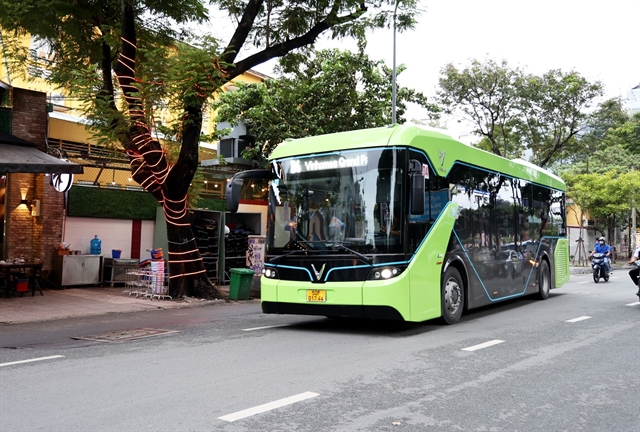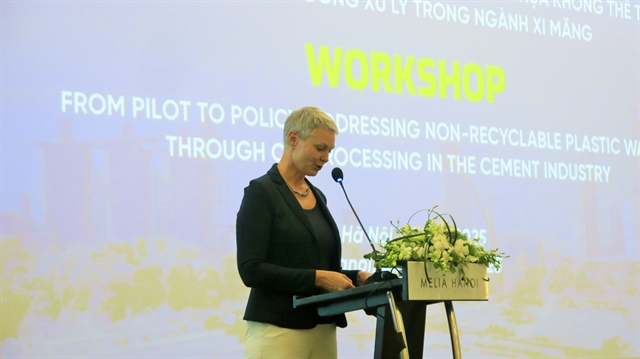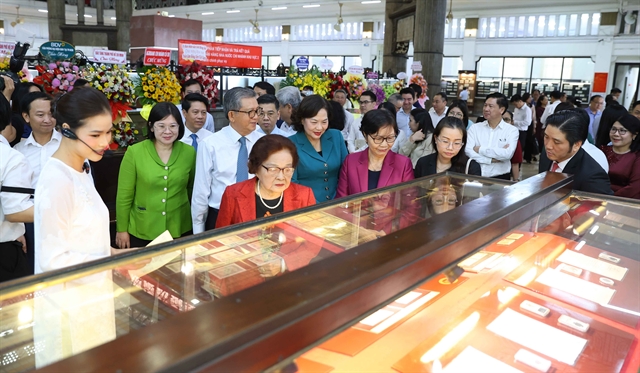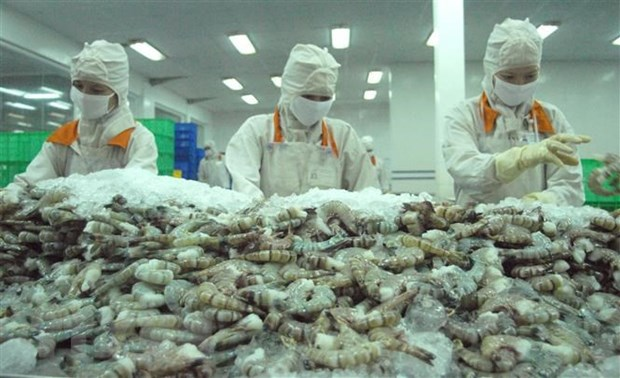 Environment
Environment

.jpg) |
| Plastic waste at Minh Khai Craft Village in the northern province of Hưng Yên.—VNA/VNS Photo Mạnh Khánh |
Nguyễn Hằng
HÀ NỘI — A clear legal framework needs to be finalised, incentives introduced to attract investment and an efficient waste management system build transforming cement kilns into 'green factories'.
Experts say this would simultaneously tackle plastic pollution and cut industrial emissions to unlock the potential of waste co-processing in cement plants.
Kare Helge Karstensen, Chief Scientist at SINTEF, one of Europe's largest independent research organisations, said Việt Nam could harness its co-processing potential through three decisive actions.
It should also introduce mandatory regulations, requiring all waste with a calorific value above 1,500 kcal/kg to be directed to cement kilns or waste-to-energy (WtE) plants, with clear timelines and phased targets.
Strengthening waste separation at source to improve the quality of refuse-derived fuel (RDF) and ensure transparency is also necessary.
Việt Nam is advised to enforce QCVN 41:2025 to global standards; update emission limits and align them with the best available techniques and practices (BAT/BEP); implement continuous emission monitoring systems (CEMS), require independent audits and make data publicly accessible to ensure reliability.
Suggestions are also needed to encourage infrastructure for waste collection and RDF production, support the development of pre-treatment centres for RDF through public–private partnerships (PPPs), adjust waste treatment fees, offer tax exemptions and carbon credits based on the thermal substitution rate (TSR) achieved by enterprises.
Standardising RDF quality is also essential to guarantee a stable and long-term fuel supply for cement kilns.
Karstensen made the recommendations at the workshop 'From Pilot to Policy: Addressing Non-Recyclable Plastic Waste through Co-Processing in the Cement Industry', held in Hà Nội on Friday.
The event was jointly organised by the Norwegian Embassy in Việt Nam, the Việt Nam Cement Association and SINTEF.
Associate Professor Lương Đức Long, Vice Chairman of the Việt Nam Cement Association, emphasised that the association hopes to work closely with environmental companies to convert waste into alternative fuels.
He also called for concrete Government incentives so that businesses engaged in co-processing can benefit from support policies, and for technical consultancy organisations to assist in transferring co-processing technology.
“With shared determination, we can scale up this model, turning waste into ‘black gold’, making cement plants ideal co-processing facilities, and contributing to a greener, cleaner, more beautiful Việt Nam in the era of national growth,” he said.
Việt Nam Cement Association Chairman, Nguyễn Quang Cung, said that waste now exists virtually everywhere, on land, in cities, across the oceans and even on Mount Everest.
Although various technologies are used for waste treatment, many generate secondary pollution during processing.
“Co-processing waste in cement clinker kilns is seen as the most complete treatment solution, as it generates no new pollution,” he said.
While treating waste, including plastic and marine debris, offers clear environmental benefits, it also requires State mechanisms to provide financial support and guidance on waste collection and pre-treatment by region, prioritising suitable technologies, he added.
Norwegian Ambassador to Việt Nam Hilde Solbakken said that co-processing can be a complementary solution, working alongside other waste management systems.
Dry, burnable materials such as low-value plastics and old textiles are ideal for cement kilns, while mixed household waste can be directed to waste-to-energy plants.
“With good planning and coordination, Việt Nam can harmonise different approaches, maximise available waste and expand its treatment capacity,” she added.
“Scaling up this solution requires more than technical know-how.”
It demands supportive policies, reliable financing and active participation from private sector partners.
Inter-ministerial collaboration across the environment, construction, industry and finance sectors is vital, along with a focus on innovation and long-term sustainability.
At the local level, waste systems must be ready to handle and segregate low-value plastics, especially from informal workers and craft villages.
Huge potential but challenges ahead
Talking to Việt Nam News on the sideline of the workshop, Karstensen said while around 10 to 12 cement plants in Việt Nam currently engage in co-processing, the country has nearly 60 plants and 90 kilns, signalling enormous untapped potential.
However, he cautioned that cement plants need reliable waste sources nearby, typically within a 200-kilometre radius, to ensure cost-effective operations.
Karstensen also said that logistics and supply chains are crucial.
Some cement plants are far from waste sources, making transport costs too high.
There needs to be synergy between waste generation, supply and processing, and local authorities must be open to co-processing, he said.
“Crucially, there must be a level playing field,” he said.
Waste-to-energy incinerators in Việt Nam often receive subsidies or tax breaks, whereas co-processing does not, creating an uneven policy environment. Both options should be treated equally, economically and regulatory.
Long, Vice Chairman of the Việt Nam Cement Association also pointed out that “the biggest challenge now is the unstable waste supply".
Cement plants were originally designed to use coal and shifting to co-processing requires additional investment.
“If plants cannot operate continuously due to insufficient waste, the business case is weak, so many are hesitant to invest,” he said.
He added that environmental impact assessment (EIA) requirements are another barrier.
“Factories wishing to adopt co-processing must redo their EIAs, which are time-consuming and complicated. Simplifying EIA procedures would greatly encourage investment,” he said.
 |
| Norwegian Ambassador to Việt Nam Hilde Solbakken addresses the workshop in Hà Nội on Friday. — VNS Photo Nguyễn Hằng |
Perfect solution to plastic waste
Karstensen, also Director of the Ocean Plastic Turned into an Opportunity in Circular Economy (OPTOCE) Programme, said co-processing non-recyclable plastics in cement kilns is not only technically feasible and environmentally sound but also capable of delivering rapid, large-scale impact.
Norway’s assessment shows that Việt Nam faces a 'double challenge', rising plastic waste and increasing carbon emissions.
Rapid urbanisation and consumption have driven a surge in hard-to-recycle plastics, many of which leak into rivers and seas, threatening marine ecosystems and coastal livelihoods.
At the same time, Việt Nam is striving for net-zero emissions by 2050 and implementing its Just Energy Transition Partnership (JETP) commitments.
Ambassador Solbakken said that in the context, co-processing non-recyclable plastics in cement kilns offers a scientifically proven, practical solution: diverting plastics from landfills and waterways, replacing fossil fuels, and reducing greenhouse gas emissions, all in one integrated process.
Cement kilns operate at extremely high temperatures, destroying hazardous compounds completely. Instead of generating ash waste, minerals are absorbed directly into the cement product. Unlike traditional incineration, co-processing prevents methane emissions and produces no toxic fly ash.
She also said, co-processing is also financially compelling.
A study in India found that using co-processing to treat waste costs around US$25 per tonne, less than half $62 per tonne it takes to burn it in traditional incineration.
“This makes co-processing a quicker and cheaper way to cut down on coal and reduce plastic pollution,” she added.
This is particularly relevant to Việt Nam, where the cement sector emits over 60 million tonnes of CO₂ annually, accounting for more than 15 per cent of national emissions.
“Co-processing offers a cleaner, climate-friendly pathway that supports Việt Nam’s net-zero ambition,” she said.
Turning plastic waste into opportunity
Data revealed at the workshop said Việt Nam’s per capita plastic consumption has risen tenfold, from 4kg in 1990 to 40kg today.
The country produces over 3.5 million tonnes of plastic waste annually, with 60-70 per cent dumped at 1,180 largely substandard landfill sites.
Only about 20 per cent is recycled, mostly PET and HDPE , while while flexible plastics lack markets .
By 2030, as much as 373,000 tonnes of plastic could leak into waterways, double the 2018 figure.
The Norwegian-funded project OPTOCE, led by SINTEF, has demonstrated the power of large-scale co-processing. The programme was launched in Việt Nam in 2019.
Across eight Asian countries, including Việt Nam, 20 pilot trials have already processed more than one million tonnes of non-recyclable plastic from rivers and landfills, replacing 500,000 tonnes of coal and significantly cutting CO2 emissions.
Scientific assessments confirm that co-processing is environmentally safe and does not increase dioxin or other pollutant emissions.
In Việt Nam, OPTOCE has partnered with major cement producers for pilot projects.
INSEE (formerly Holcim) in Hòn Chông Island, southern Việt Nam, has co-processed plastic waste from the country’s largest paper producer and the leather industry.
In the north, Lam Thạch Cement Plant has successfully treated non-recyclable plastic waste from Minh Khai craft village in Hưng Yên Province and Tràng Minh craft village in Hải Phòng City.
Both INSEE and Lam Thạch have achieve TSR rates of 35-40 per cent.
These results dispel doubts about technical feasibility and environmental safety, proving that with the right policies and cooperation, Việt Nam can rapidly expand co-processing, reducing coal use and cutting plastic leakage. — VNS


.jpg)

